J.J. Moon is a fictional character and simply plays on the George Orwell Moon Under Water theme of some of the company’s earliest pubs.
The text reads: This parade of shops was developed in the mid 1930s, after the underground station opened in 1932. Number 553 and 555 were combined in the mid-1950s, and occupied by the Circle Furnishing Company for many years.
The railway brought a population explosion. The total population was 1856 in 1921. It rose to over 30,000 in the 1930s, and by 1951 it had reached 42,000.
The line through Kingsbury was originally the Metropolitan, but later became the Bakerloo.
Photographs, illustrations and text about Kingsbury Manor.
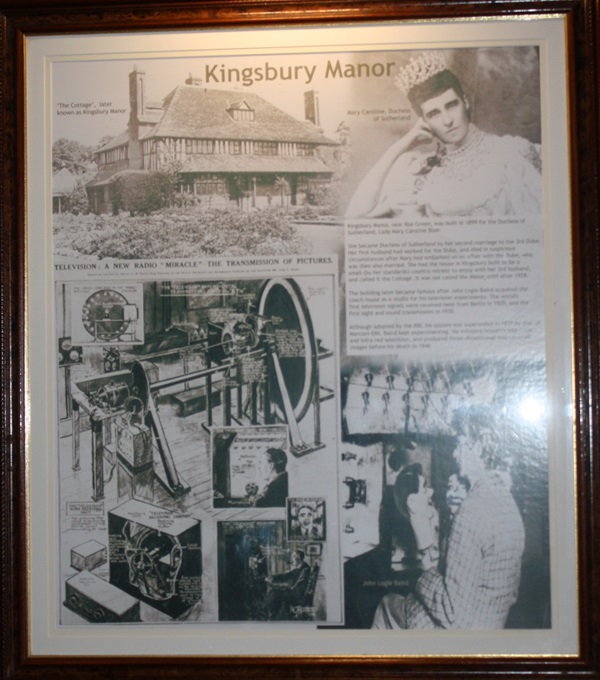
The text reads: Kingsbury Manor, near Roe Green, was built in 1899 for the Duchess of Sutherland, Lady Mary Caroline Blair.
She became Duchess of Sutherland by her second marriage to the 3rd Duke. Her first husband had worked for the Duke, and died in suspicious circumstances after Mary had embarked on an affair with the Duke, who was then also married. She had the house in Kingsbury built to be a small (by her standards) country retreat to enjoy with her 3rd husband, and called it the Cottage. It was not called the Manor until after 1928.
The building later became famous after John Logie Baird acquired the coach house as a studio for his television experiments. The world’s first television signals were received here from Berlin in 1929, and the first sight and sound transmission in 1930.
Although adopted by the BBC his system was superseded in 1937 by that of Marconi-EMI. Baird kept experimenting. He initiated research into radar and infra-red television, and produced three dimensional and coloured images before his death in 1946.
Illustrations and text about hay and horses.
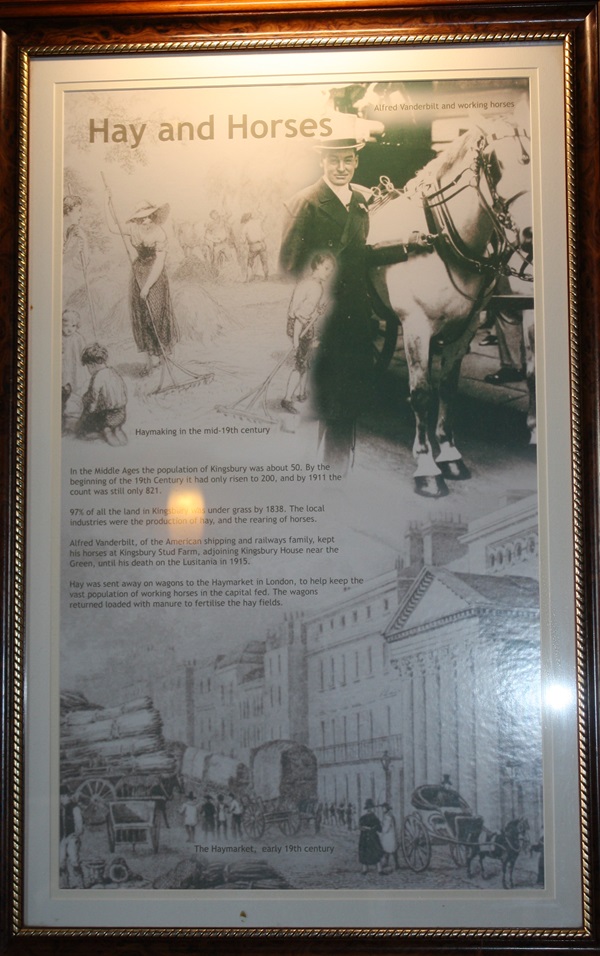
The text reads: In the Middle Ages the population of Kingsbury was about 50. By the beginning of the 19th century it had only risen to 200, and by 1911 the count was still only 821.
97% of all the land in Kingsbury was under grass by 1838. The local industries were the production of hay, and the rearing of horses.
Alfred Vanderbilt, of the American shipping and railways family, kept his horses at Kingsbury Stud Farm, adjoining Kingsbury House near the Green, until his death on the Lusitania in 1915.
Hay was sent away on wagons to the Haymarket in London, to help keep the vast population of working horses in the capital fed. The wagons returned loaded with manure to fertilise the hay fields.
Photographs, illustrations and text about the Lyon family.

The text reads: Lyon Farm, 1939. This was the 18th century building that replace John Lyons’ farmhouse. The Perrin family left it to Wembley Council who demolished it in the 1960s.
Lyon Farmhouse in nearby Preston had been the home of the Lyon family since 1393. John Lyon, who founded Harrow School in 1572, and gave the farm’s income to fund his establishment, was born there in 1534.
Like Kingsbury, Preston also has a Saxon name. It means “the farm belonging to the priest”, and is first recorded in the year 1220. By the mid-15th century Preston consisted of two farms and a few cottages.
Photographs and text about aviation in Kingsbury.
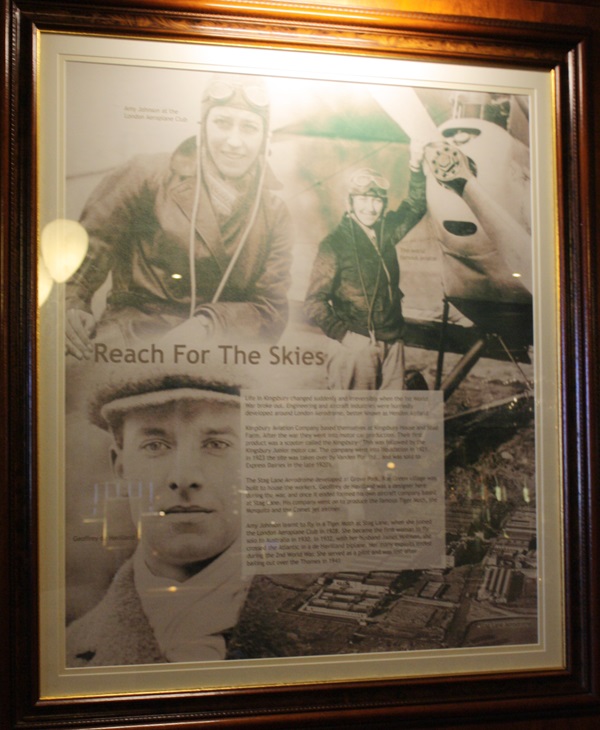
The text reads: Life in Kingsbury changed suddenly and irreversibly when the 1st World War broke out. Engineering and aircraft industries were hurriedly developed around London Aerodrome, better known as Hendon Airfield.
Kingsbury Aviation Company based themselves at Kingsbury House and Stud Farm. After the war they went into motor car production. Their first product was a scooter called the Kingsbury. This was followed by the Kingsbury Junior motor car. The company went in liquidation in 1921. In 1923 the site was taken over by Vanden Plas ltd., and was sold to Express Dairies in the late 1920s
The Stag Lane Aerodrome developed at Grove Park. Roe Green village was built to house the workers. Geoffrey de Havilland was a designer here during the war, and once it ended formed his own aircraft company based at Stag Lange. His company went on to produce the famous Tiger Moth, the Mosquito and the Comet jet airliner.
Amy Johnson learnt to fly in a Tiger Moth at Stag Lane, when she joined the London Aeroplane Club in 1928. She became the first woman to fly solo to Australia in 1930. In 1932, with her husband James Mollison, she crossed the Atlantic in a de Havilland biplane. Her many exploits ended during the 2nd World War. She served as a pilot and was lost after bailing out over the Thames in 1941.
An illustration and text about Lewgars.

The text reads: The antiquarian E. N. Haxell extended an older building, using materials discarded in the refurbishment of St Andrew’s Church during the 1870s, to create this elaborate mansion as seen above in 1910.
In the 1890s the resident was Mr Brookes, the manufacturer of Monkey brand soap.
Text about literary locals.
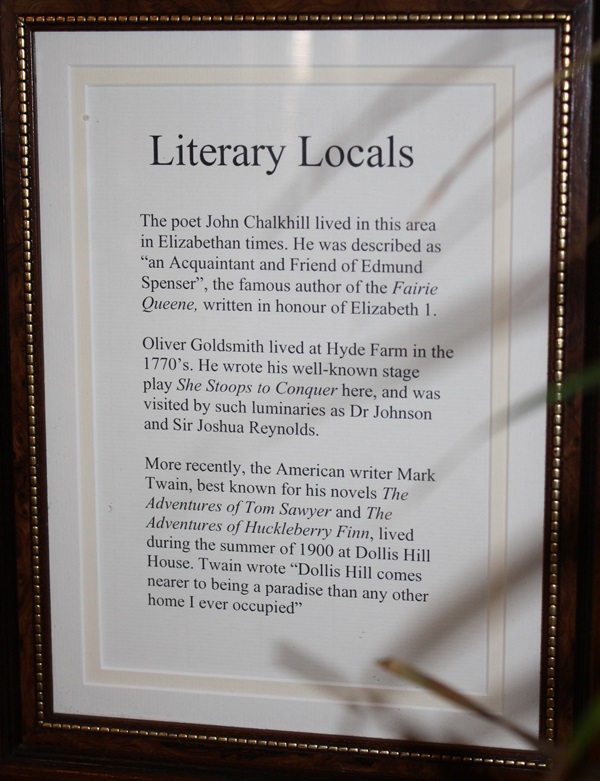
The text reads: The poet John Chalkhill lived in this area in Elizabethan times. He was described as “an Acquaintant and Friend of Edmund Spenser”, the famous author of the Faire Queene, written in honour of Elizabeth 1.
Oliver Goldsmith lived at Hyde Farm in the 1770s. He wrote his well-known stage play She Stoops to Conquer here, and was visited by such luminaries as Dr Johnson and Sir Joshua Reynolds.
More recently, the American writer Mark Twain, best known for his novels The Adventures of Tom Sawyer and The Adventures of Huckleberry Finn, lived during the summer of 1900 at Dollis Hill House. Twain wrote “Dollis Hill comes nearer to being a paradise than any other home I ever occupied”
Prints of Mark Twain at Dollis Hill House.
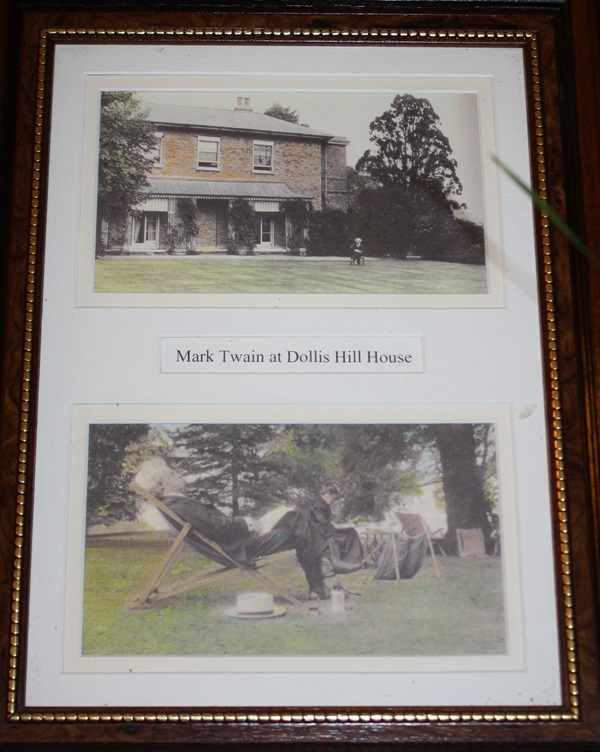
A print of Oliver Goldsmith.
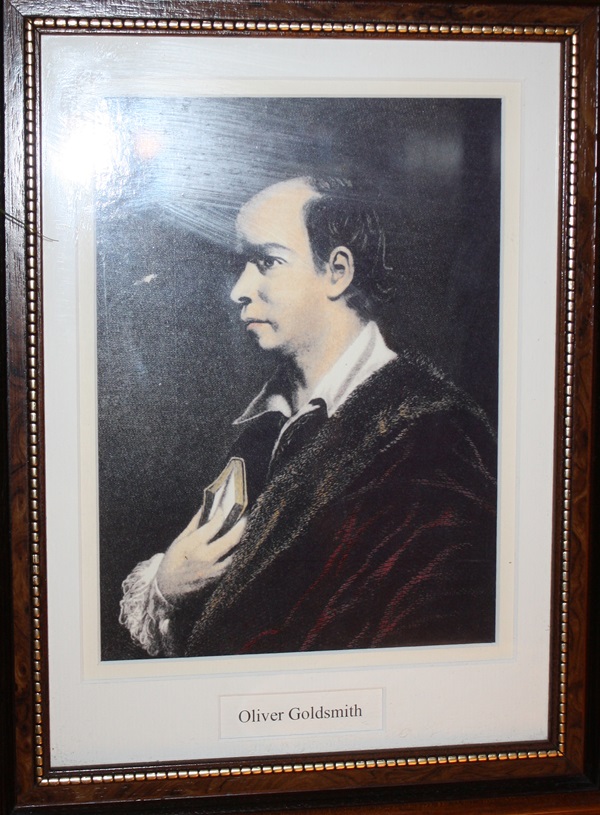
Text about the Welsh Harp.

The text reads: Plans for the Welsh Harp Reservoir (also known as Kingsbury Reservoir) were first implemented by the Regents Canal Company in 1819, and work was completed in 1837.
The Old Welsh Harp inn, from which the reservoir takes its name, was situated on the Edgware Road. From 1859 until 1889 it was run by W. P. Warner, and it became a major venue for Londoners. Its best known attractions were the Kingsbury steeplechase race course, and the Music Hall.
Two of the greatest Music Hall stars who performed at the Welsh Harp also popularised songs about the place. Miss Annie Adams sang “The Jolliest Place That’s Out”, and Albert Chevalier (known as the ‘Coster Laureate’), sang “The Coster’s Serenade”.
External photograph of the building – main entrance.

If you have information on the history of this pub, then we’d like you to share it with us. Please e-mail all information to: pubhistories@jdwetherspoon.co.uk